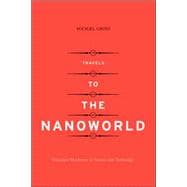
Note: Supplemental materials are not guaranteed with Rental or Used book purchases.
Purchase Benefits
| I. Introduction | |||||
|
3 | (22) | |||
|
5 | (4) | |||
|
9 | (2) | |||
|
11 | (3) | |||
|
14 | (2) | |||
|
16 | (2) | |||
|
18 | (1) | |||
|
19 | (6) | |||
| II. The Role Model: The Living Cell as a Nanotechnological Factory | |||||
|
25 | (30) | |||
|
27 | (4) | |||
|
31 | (1) | |||
|
32 | (5) | |||
|
37 | (1) | |||
|
38 | (5) | |||
|
43 | (4) | |||
|
47 | (8) | |||
|
55 | (36) | |||
|
56 | (4) | |||
|
60 | (2) | |||
|
62 | (2) | |||
|
64 | (6) | |||
|
70 | (3) | |||
|
73 | (3) | |||
|
76 | (4) | |||
|
80 | (2) | |||
|
82 | (4) | |||
|
86 | (5) | |||
|
91 | (22) | |||
|
92 | (2) | |||
|
94 | (2) | |||
|
96 | (2) | |||
|
98 | (4) | |||
|
102 | (3) | |||
|
105 | (8) | |||
| III. Toward the Nanoworld: Biology, Chemistry, and Physics Pave the Way for Nanotechnology | |||||
|
113 | (32) | |||
|
114 | (2) | |||
|
116 | (1) | |||
|
117 | (5) | |||
|
122 | (4) | |||
|
126 | (4) | |||
|
130 | (3) | |||
|
133 | (4) | |||
|
137 | (2) | |||
|
139 | (6) | |||
|
145 | (28) | |||
|
146 | (3) | |||
|
149 | (3) | |||
|
152 | (2) | |||
|
154 | (4) | |||
|
158 | (1) | |||
|
158 | (2) | |||
|
160 | (4) | |||
|
164 | (3) | |||
|
167 | (3) | |||
|
170 | (3) | |||
|
173 | (18) | |||
|
175 | (2) | |||
|
177 | (1) | |||
|
178 | (6) | |||
|
184 | (1) | |||
|
185 | (6) | |||
| IV. A Big Future for Tiny Machines? | |||||
|
191 | (10) | |||
|
192 | (2) | |||
|
194 | (2) | |||
|
196 | (1) | |||
|
197 | (1) | |||
|
198 | (3) | |||
|
201 | (18) | |||
|
202 | (1) | |||
|
203 | (1) | |||
|
204 | (3) | |||
|
207 | (4) | |||
|
211 | (3) | |||
|
214 | (5) | |||
|
219 | (10) | |||
|
221 | (1) | |||
|
222 | (1) | |||
|
222 | (2) | |||
|
224 | (1) | |||
|
225 | (4) | |||
| Glossary | 229 | (8) | |||
| Further Reading and Internet Links | 237 | (12) | |||
| Index | 249 |
The New copy of this book will include any supplemental materials advertised. Please check the title of the book to determine if it should include any access cards, study guides, lab manuals, CDs, etc.
The Used, Rental and eBook copies of this book are not guaranteed to include any supplemental materials. Typically, only the book itself is included. This is true even if the title states it includes any access cards, study guides, lab manuals, CDs, etc.